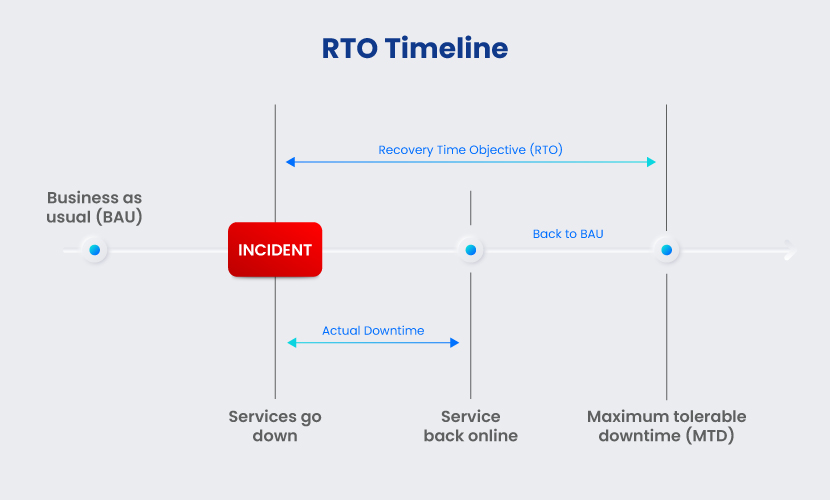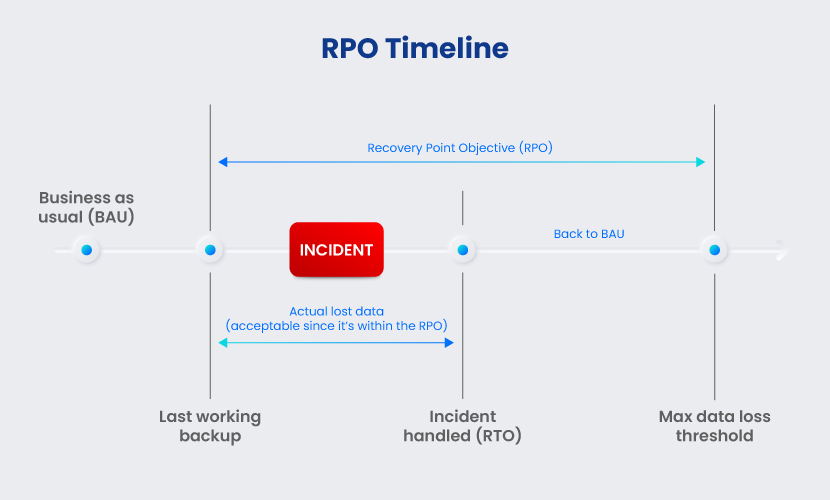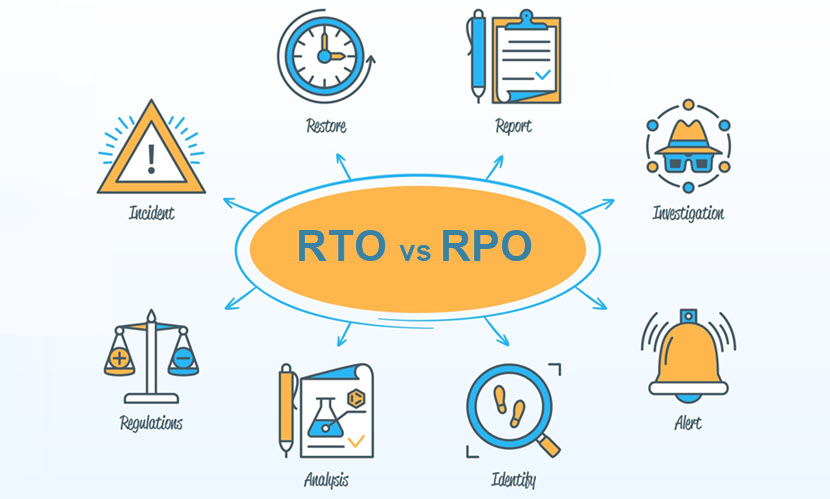While the two metrics sound similar, they play completely different roles in disaster recovery and backup (BDR). This article provides a detailed RTO and RPO comparison
to explain each metric’s unique role in BC planning. While they share similar goals, disaster recovery and business continuity are not interchangeable. Learn the difference between the two practices in our in-depth business continuity vs disaster recovery comparison.
RTO vs RPO Main DifferencesHere’s what RTO and RPO stand for:RTO (Recovery Time Objective) is the time frame within which an asset (product, service, network, etc.) must come back online if it goes down.
RPO (Recovery Point Objective) is the acceptable amount of data (measured by time) a company is willing to lose in case of an incident.
Both metrics are measurements of time and are vital to effective disaster recovery. RTOs require comprehensive planning, and RPOs do too, but they differ in several ways.
RTO focuses on infrastructure and app recovery, while RPO focuses on the frequency of backups and acceptable data loss. RPO only assesses the criticality of data and the cost of replication.
- RTO is the more complex process of the two as it involves more moving parts and variables (hot and cold sites, failovers, go-to response teams, etc. ).
- An RPO relies heavily on automation to back up and restore data, while RTOs involve more manual tasks and a more hands-on approach to recovery.
RPO is easier to calculate as the metric only covers one aspect of the recovery process–data.
- Low RPOs are far cheaper than low RTOs due to the significant difference in scope.
- Together, RTOs and RPOs enable a business to know
- how long it can afford to be down
- and
- how recent the data will be following the recovery
- . Most companies prefer bouncing back from disruptions as quickly as possible, but the shorter an RTO or RPO is, the cost of recovery goes up (and vice versa).
The best way to guarantee low RTOs and RPOs without expensive upfront investments is to rely on Disaster-Recovery-as-a-Service (DRaaS). DRaaS will ensure that you can get back to normal business in minutes, not hours or days. RTO can be 30 minutes for a system. The RTO clock starts when the affected system fails and stops when it is fully operational. Some RTOs begin when the responsible team receives a notification of the incident. This is more common with non-mission critical systems. RTA is the duration of recovery. RTAs are not always identical to RTOs, but it is important that the RTA stays within the RTO’s timeframe (RTA >= RTO). There’s no reason to set a low RTO on every asset. Each system is different in its tolerance for downtime. How to Calculate RTOThere is no formula that will work for all companies or systems. Figuring out an optimal recovery time frame starts with an in-depth risk and business impact analysis (BIA) that examines each asset’s unique traits, including:Consequences of the system going down (monetary, regulative, reputational, etc. ).Overall mission-criticality (i.e., how impactful system downtime would be to other systems and end-users).The estimated cost of an outage (typically calculated in minutes or hours)
Maximum tolerable period of disruption (MTPD).
Assessed vulnerabilities currently in the system.
The current security measures and features that protect the asset.
Potential threats (power outages, local natural disasters, specific types of cyber attacks, etc. ).
The likelihood of the system experiencing problems.Industry-specific compliance implications.Once there’s an in-depth understanding of the system, the analysis team defines an optimal RTO from an IT perspective. The next step is to consult with the business unit leaders and senior management to determine whether the suggested RTO is viable from a budget standpoint.
In the case of RTOs, faster always means costlier. RTOs that require the system to return online within an hour will cost a lot of money. Do not set RTOs too low for each asset. Determining RTOs requires a balancing act between:

Consequences of the system suffering downtime.
- The risk of something going wrong with the system.
- The price of setting up the recovery process.
- More than
- 72% of companies are unable to meet their RTO expectations
- . Calculate recovery times realistically. A high RTO, which your staff or system cannot achieve, will not help you in a crisis. RPOs are measured in minutes or hours since the last backup of working data. Once the RPO period passes in a disaster scenario, the quantity of lost data exceeds the maximum allowable threshold.
- For example, if a system has an RPO of 3 hours, the team must have a working copy of data not older than 3 hours at all times. RPOs do not usually apply to historical or archived data. This metric is based on the most recent transactional files or updates to a system.
- The RPO determines how often a company should create backups in order to avoid data loss exceeding the tolerance threshold. The shorter the RPO, the less data is at risk of loss (either permanent or temporary).
- Like with RTOs, shorter RPOs require a more significant investment than longer ones. Zero or near-zero RPOs typically require:
- High-speed backup tech (such as continuous replication and data mirroring).
High amounts of network bandwidth to transmit data.
These measures are expensive to set up and maintain, so determining RPOs requires the team to find the middle ground between: The impact of data loss.The cost of setting up backup and recovery measures.
- Any data set with an RPO should also measure the
- Recovery Point Actual (RPA)
- . The RPA is the actual amount of data lost during an incident. Therefore, the RPA should be equal or lower than the RPO. RPOs are determined by a thorough analysis of the data. Here are the primary factors:
The financial and operational consequences of losing data.Likelihood of incidents.The number of applications that rely on the data set.
The cost of implementing the RPO strategy.
Relevant storage regulations.
Most companies back up their data at a fixed interval (once an hour, a day, a week, etc.). Here are the four most common RPO time frames and a few usual use cases:
Continuous or zero RPOs: Data sets that can’t afford losses due to mission-criticality, regulations, or being challenging to recreate. Examples include payment gateway info, patient records, and stock market trading activities.
One to four hours:
This time frame is standard for semi-critical business units with limited loss tolerance. Examples are customer chat logs, product dashboards, and password authentication systems.
- Four to twelve hours:
- This RPO is the go-to option for data sets that have little impact on a business if something goes wrong, such as marketing or sales statistics databases.
Between 13 and 24 hours:
- Longer RPOs are a good fit for non-critical data, such as purchase orders or inventory control files.
- Most data sets that do not fall under one of the categories above require weekly backups. You have two options when choosing how to back up your data:
On-site: You store replicas at a different computer or server room in your office. These backups are vulnerable to localized events that impact both primary and secondary storage.Off-site:
Keeping data backups at a secondary facility or a third-party data center removes the danger of losing all storage solutions to a single incident. Most companies that have off-site backups rely on cloud storage.

Puyka’s backup and restore solutions offer state-of-the-art tech that enables you to keep replicas in different geographic regions and meet even the strictest RPOs.
RTO vs RPO: Vital Thresholds for Downtime and Data Loss
- Predicting exactly when incidents will occur is impossible, but preparing for unfortunate events is not. RTOs and RPOs that are reliable will ensure you have control over the aftermath of any problems, and won’t negatively impact your bottom-line. Most companies will not hesitate to set aside the time and resources necessary to prepare RTOs or RPOs.
